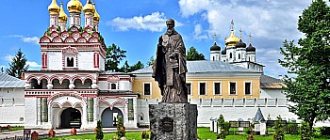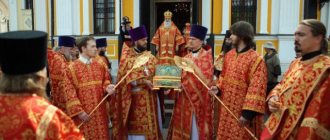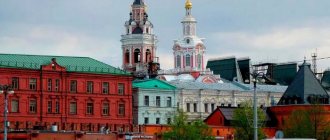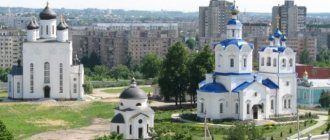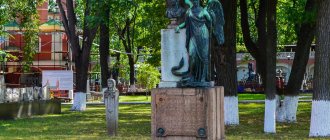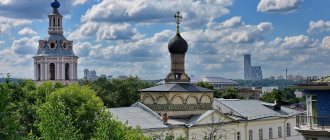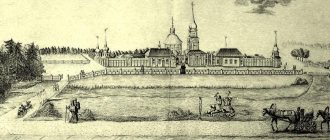The male stauropegial (independent of the local diocese) monastery is located in the village of Teryaevo, 16 km from Volokolamsk. The ancient desert opens its gates to tourists and pilgrims every day, offering intriguing architecture and a peaceful atmosphere. Since ancient times, the Joseph-Volotsky Monastery served as a fortification on the path of blasphemous invaders.
In the 20th century, the complex and the brethren experienced great sorrows, the buildings suffered from reconstruction, and the monks from arrests. Today the monastery is being restored and is regaining the authority it had during the time of the monarchs.
Joseph-Volotsky Monastery, Volokolamsk district, Moscow region
Shrines of the Joseph-Volotsky Monastery
The miraculous remains of the founder of the desert were found in 2001 in the Assumption Church, on the day of his memory. The akathist addressed to St. Joseph is read every Sunday. After ritual services, pilgrims are allowed to touch the relics, which emit a divine fragrance.
The relics of St. Joseph of Volotsk in the Assumption Cathedral of the Joseph-Volokolamsk Monastery
Joseph's chains are a set of iron chains, plates and crosses. Before the revolution, they were kept in the main church of the monastery, and after that they were transported to the local history museum. Joseph wore the chains, which weighed 15 kg, every day, never taking them off; they learned about them only after the death of the founder.
The monastery contains a list of the icon “Recovery of the Lost,” which has been enormously revered in Rus' since ancient times. Diligent prayers to this icon save people’s lives and heal them from incurable diseases. Here the laity can see the Volokolamsk Icon of the Mother of God, copied from the original in 2007. Before being sent to the Volotsk Monastery, the icon was consecrated in the A. Rublev Museum and attached to the miraculous original, painted in the 16th century.
On a note! The brethren of the monastery work with orphans, youth, WWII veterans, political refugees and disadvantaged people. The monastery mercifully provides them with clothing and food, medical care and good advice.
History of the formation of the monastery
The credit for its founding belongs to Joseph Volotsky, who is considered a saint. The construction of the shrine took place in the domain of Prince Boris Vasilyevich of Volotsk at the end of the 15th century, on one of the Orthodox holidays. The monastery, initially called Uspensky, was subordinate to the Novgorod diocese before becoming the property of the Moscow Metropolitan. Initially, it was entirely wooden, but 6 years after its founding, a stone complex was built in its place - this happened during Joseph’s life. Later, the Orthodox saint, by right of hegumen, streamlined the services held here and introduced special rules that the local monks had to follow. But the order established here was destroyed with the appearance within its walls of aggressive nobles from Lithuania and Poland. And even the powerful fortress walls did not protect the monastery from destruction. In the XVI-XVII centuries. Joseph-Volotsky Monastery has changed a lot. By order of the authorities, guilty members of the clergy and state criminals began to be sent to it. Such famous historical figures as Maxim the Greek, Metropolitan Daniil, Vasily IV Shuisky, Vasily Kuritsyn, and the heretic Matvey Bashkin visited here. Polish prisoners of war were also imprisoned in the monastery - in the 17th century, and French - during the Patriotic War of 1812. In the 18th century, the complex served as a school for future church officials, although it did not last long. In terms of the amount of land ownership, no other church in the region could compare with the Joseph-Volotsk Monastery. His domain included many villages, wastelands and rural settlements. However, the situation changed after the state confiscated some lands. The area of land owned by the temple decreased to 305 hectares in Klin and Volokolamsk districts. Afterwards, church officials decided to purchase another 350 hectares of fertile land.
Many of the icons kept on the territory of the monastery were created by the hands of the famous icon painter, a follower of the traditions of Andrei Rublev, Dionysius, working together with his sons. The latter began painting images on the initiative of Joseph. At the end of the 18th century, the prayers of St. Joseph saved many people from the plague that broke out in the city. The good deed was not forgotten by the local residents, among them the custom arose of organizing a religious procession from Volokolamsk to the Joseph-Volotsky Monastery with an icon of the saint in their hands. In the 90s XX century Joseph-Volotsky Monastery became an integral part of the Russian Orthodox Church. A number of transformations have been made to it. The main temple was restored, and an Orthodox museum began operating there. The monastery of St. Joseph regained its original purpose as a men's monastery complex.
Modern life
The return of the monastery to the Russian Orthodox Church took place on May 15, 1989. Stauropygial status was achieved in 1999. The first rector after his return was Metropolitan Pitirim. He was in charge until the winter of 2003.
On June 12, 2003, the relics of Joseph Volotsky were opened in the monastery, which were placed in the reliquary of the Assumption Cathedral. Archaeologists opened the grave and then handed over the relics for research. The relics were examined by forensic experts, doctors of science and other researchers.
A year later, the chains of the same Joseph of Volotsky, previously stored in the state budgetary cultural institution “New Jerusalem”, and even earlier in the “Volokolamsk Kremlin” were delivered to the monastery. The saint wore them under his clothes. Now the chains are available on the territory of the Assumption Cathedral; they can be worshiped at the southern wall .
Two days after receiving the chains, Patriarch Alexy II visited the Joseph-Volokolamsk Monastery. He conducted the Divine Liturgy.
In June 2009, a monument to St. Joseph was built near the monastery; the material used was bronze and stone. The work was carried out by sculptor Sergei Isakov.
Back in 1954, the Volokolamsk Icon of the Mother of God was taken from the monastery and transferred to the Central Museum of Ancient Russian Culture. In 2007, an icon painted in the image and likeness of the original was delivered to the monastery. It was created by the icon painter S.I. Fomin.
Troubled times
During the Time of Troubles, Vasily Ivanovich Shuisky ruled the country, and the monastery was on his side. In 1606, the monastery was besieged by the leader of the uprising, Ivan Isaevich Bolotnikov. Three years later the Poles came here. In 1610, the monastery was occupied by the soldiers of Colonel Rozhinsky, an ally of False Dmitry II. While fighting with opponents, Rozhinsky landed extremely unsuccessfully on his side, in which he had been wounded shortly before. As a result, the stitches came apart and he died a couple of days later.
Command passed to Captain Rutsky, who drove out the Russian-Swedish army under the leadership of Voivode Valuev and General Gorn from the monastery.
When Prince Dmitry Shuisky was defeated in the Battle of Klushino on June 24, 1610 and an uprising occurred in Moscow, Vasily Shuisky lost his throne. This happened on July 17, when part of the boyars and nobility were forcibly tonsured into monks. Moreover, Vasily Ioannovich refused to pronounce monastic vows. He was sent to the Joseph-Volotsky Monastery.
The brothers of Vasily Shuisky were sent to the Belaya fortress. In September of the same year, the prince and his brothers were handed over to the Polish commander Zolkiewski, who defeated the Russian-Swedish army at Klushin.
During the Russian-Polish War, soldiers of the Polish-Lithuanian Commonwealth were kept in custody in the monastery. During the battles with Napoleon there were French prisoners there. For a long time, the priest's sons studied in the Volokolamsk monastery of Joseph of Volotsky.
The relics of St. Joseph rest in the Cathedral of the Assumption of the Blessed Virgin Mary. In addition, the monastery contains the burial places of other famous people:
- Prince Ivan Borisovich Ruzsky.
- Fyodor Borisovich Volotsky.
- Metropolitan Daniel.
- Novgorod Archbishop Theodosius.
- Assistant to Ivan the Terrible - Malyuta Skuratov.
- Mother-in-law of Alexander Sergeevich Pushkin - Natalya Ivanovna Goncharova.
In addition to the burials, the monastery had a huge library for those times, where, in addition to books, various charters, manuscripts, acts and other documents of old times were kept. There were also very rare items there.
In the spring of 1858, peasant unrest occurred in the provinces located in the central district, and there were rumors about the implementation of the Peasant Reform. A year later, a wave of sober unrest began - peasants and townspeople did not agree with the tax farming system. Directly near the Joseph-Volokolamsk Monastery, a large crowd of people destroyed establishments where strong drinks were served. About 3 thousand peasants gathered.
Before Nicholas II abdicated his throne, fairs of the Kaleevskaya volost were held on the territory of the monastery. After the October Revolution occurred, the monastery was converted into a commune. This was done with all monastic and landowner lands. Hieromonk Paphnutius was appointed chairman of the labor brotherhood. The monastery voted for him unanimously.
Five years later, the commune was dissolved and the monastery was closed. All letters, books, writings and documents were distributed in the following places:
- Russian State Archive of Ancient Acts.
- State Historical Museum.
- Russian State Library.
- Institute of Russian History RAS.
After the monastery was closed, children from the orphanage were housed in the buildings. The fraternal building was assigned to the Children's City School. A cinema hall appeared in the cathedral, behind which all the icons were hidden.
It is worth noting that the territory of the monastery has always been different. Until the 30s of the last century, it was part of the Buigorod volost, after which it was on the lands of the Volokolamsk region. Now it is located near the village of Teryaevskoye.
The Great Patriotic War
At the very beginning of the Great Patriotic War, almost all children were evacuated, some orphanages died during the trip. When Army Group Center set out to conquer Moscow in 1941, the Soviet Western Front stood in their way. In the fall of 1941, the Volokolamsk direction played a major role in the defense of the capital. The task of preserving it fell to the 16th Army, led by Hero of the Soviet Union Konstantin Konstantinovich Rokossovsky. The monastery itself was occupied by soldiers of the Red Army.
The fighting in the area of the Mozhaisk defense line was very stubborn, but, unfortunately, the soldiers of the Western Front were unable to hold off the advance of the fourth German army and the fourth tank group. The Red Army had to retreat to Moscow.
The leadership ordered the engineering troops to construct barriers directed against enemy tanks and infantry, install mines and landmines, and do everything possible to impede the enemy’s movement. As a result, it was possible to destroy a large section of roads and highways, about three hundred bridges. 640 high-explosive shells, more than 100 thousand tons of explosives were spent, tens of thousands of different mines were placed.
As the Red Army retreated, soldiers were ordered to destroy various buildings that offered a wide view. Actually, this is what they did with the bell tower of the Smolensk Hodegetria, built in 1495. In good weather, it was possible to see Moscow from there. Hitler's army managed to capture Teryaevo, the monastery and all nearby villages by October.
However, already on December 6, the first stage of the offensive operation of the Soviet troops began, during which the Joseph-Volotsky Monastery was liberated. 200 thousand soldiers took part in this large-scale operation, of which 88 thousand died.
After he was released, the orphanage returned there. Restoration work was carried out, but the unique bell tower was never restored.
